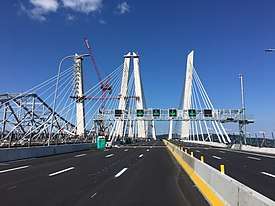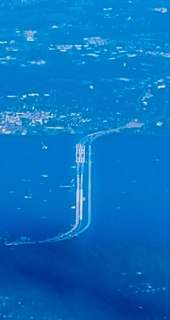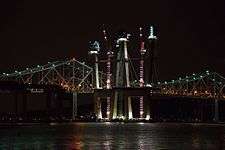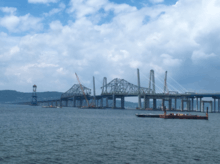Tappan Zee Bridge (2017–present)
| Governor Mario M. Cuomo Bridge (Tappan Zee Bridge) | |
|---|---|
 The new Tappan Zee Bridge, one week before its official opening | |
| Coordinates | 41°04′17″N 73°53′28″W / 41.07139°N 73.89111°WCoordinates: 41°04′17″N 73°53′28″W / 41.07139°N 73.89111°W |
| Carries |
8 lanes (4 northbound/westbound, 4 southbound/eastbound) of |
| Crosses | Hudson River |
| Locale | Connecting South Nyack (Rockland County) and Tarrytown (Westchester County) |
| Official name | Governor Mario M. Cuomo Bridge |
| Other name(s) | New NY Bridge; New Tappan Zee Bridge |
| Maintained by | New York State Thruway Authority |
| Characteristics | |
| Design | dual-span cable-stayed twin bridge |
| Total length | 16,368 ft (4,989.0 m; 3.1 mi; 5.0 km)[1] |
| Width | 183 ft (56 m), total of both decks: 87 ft (27 m) and 96 ft (29 m) |
| Height | 419 ft (128 m) |
| Longest span | 1,200 ft (370 m) |
| Clearance above | unlimited |
| Clearance below | 139 ft (42 m)[2] |
| History | |
| Construction start | 2013 |
| Construction cost | $3.9 billion (2013 project budget)[1] |
| Opened |
August 26, 2017 (westbound/northbound span)[3] September 11, 2018 (eastbound/southbound span) |
| Replaces | Tappan Zee Bridge (1955–2017) |
| Statistics | |
| Daily traffic | 138,000+ (2011 est) |
The Tappan Zee Bridge, officially named the Governor Mario M. Cuomo Bridge after former New York Governor Mario Cuomo, is a twin cable-stayed bridge built to replace the original Tappan Zee Bridge over New York's Hudson River. The new twin spans are located to the north of–and roughly parallel to–the existing Tappan Zee Bridge, crossing the Hudson River in a parallel east–west direction.
In the bridge's final configuration, the north span carries the northbound and westbound automobile traffic of I-87 and I-287; it will also carry a shared-use path for bicycles and pedestrians. The south span carries the southbound and eastbound automobile traffic of I-87 and I-287.
Tappan Zee Constructors began construction in 2013. The north span officially opened to westbound traffic on August 26, 2017; it also opened to eastbound traffic on October 6, 2017. Tappan Zee Constructors then began demolishing the old bridge. An opening ceremony for the south span was held on September 8, 2018, and traffic started using the new span three days later.
The official name of the bridge has been controversial since its announcement, with a petition and proposed legislation opposing the attachment of Mario Cuomo's name to the bridge.
Background
The Tappan Zee river crossing was named by 17th century Dutch settlers.[4] The Tappan Zee Bridge and the smaller Bear Mountain Bridge are the only crossings of the stretch of the Hudson between Westchester and Rockland counties, both of which are part of New York City's populous northern suburbs.
The original Tappan Zee Bridge was a cantilever bridge built from 1952 to 1955.[5][6] The bridge was 3 miles (4.8 km) long and spanned the Hudson at its second-widest point. It was the longest bridge in New York State, at a length of 16,013 feet (4,881 m) including approaches.[7] Built immediately after the Korean War, the bridge had a low construction budget of only $81 million and a designed life-span of only 50 years.[8] During its first decade, the bridge carried fewer than 40,000 vehicles per day.
By the 2000s, the bridge was "decaying" and "overburdened".[8] The deteriorating structure bore an average of 140,000 vehicles per day, substantially more traffic than its designed capacity.[9] The collapse of Minnesota's I-35W Mississippi River bridge in 2007 raised worries about the Tappan Zee Bridge's structural integrity.[10] These concerns, together with traffic overcapacity and increased maintenance costs, escalated the serious discussions already ongoing about replacing the Tappan Zee with a tunnel or a new bridge.[11][12] Six options were identified and submitted for project study and environmental review.[13]
Construction progress
Planning

The Federal Highway Administration issued a report in October 2011 designating the Tappan Zee's replacement to be a dual-span twin bridge. The new bridge was built a few yards to the north of the existing bridge, and connects to the existing highway approaches of the New York State Thruway (I-87/I-287) on both river banks.[14] Construction began as scheduled during October 2013,[15][16] with completion targeted for 2017.[17]
Originally, some motorists thought that bridge tolls could more than double (to $12-$15 for automobiles, eastbound only), rising to those of New York City's Hudson River crossings.[18] However, the state passed legislation freezing the toll on the bridge at $5 through 2020 in its 2016 legislative session.[19]
The new Tappan Zee Bridge was proposed to include four vehicle lanes on each span, for a total of eight lanes, as well as a shared-use bicycle and pedestrian path. Like its predecessor, the new Tappan Zee Bridge is to be administered by the New York State Thruway Authority. The authority is the project co-sponsor, along with the state Department of Transportation.[14]
Construction
The New York Metropolitan Transportation Council added the Tappan Zee Bridge to its list of projects eligible for federal funds in August 2012.[20] The United States Department of Transportation approved the plan on September 25, 2012. The approval process took fewer than 10 months as opposed to the traditional multi-year process as a result of being placed on a "fast track" for approval by the Obama Administration.[21] On December 17, 2012, New York state officials dropped their proposal for a 45 percent increase on the state Thruway toll for trucks, while advancing a $3.14 billion project to replace the bridge.[22]
The new Tappan Zee Bridge was built by Tappan Zee Constructors, a design-build LLC composed of Fluor Corporation, American Bridge Company, Granite Construction Northeast and Traylor Bros. The Left Coast Lifter was used to install groups of pre-assembled girders one full span at a time.[23] By the end of 2013, General Electric had completed four seasons of dredging to remove contaminants from the river bottom. Approximately 70 percent of the sediments targeted for dredging were removed (totaling more than 1,900,000 cubic yards (1,500,000 m3) of sediment).[24]
On July 19, 2016, a crane used for the construction of the bridge collapsed onto the existing older bridge. Five people were injured, including three drivers and two bridge workers; no one was killed or critically injured.[25][26]
Completion


The project timeline originally indicated that the old bridge would be closed in 2016 and that the demolition of the old bridge would begin in February 2017.[27] The new northbound/westbound span opened on August 26, 2017.[3][28] Southbound/eastbound traffic remained on the existing span until October 6, 2017, when it was shifted to the new northbound/westbound span to allow for the completion of the new southbound/eastbound span.[29] The northbound/westbound span of the new Tappan Zee Bridge temporarily carried four lanes in both directions until the new southbound/eastbound span was completed.[30][31]
After some delays, the project was later expected to be completed by June 15, 2018,[30] at a cost of $3.98 billion.[32] However, the scheduled opening was later pushed back to mid-September.[33] The new southbound/eastbound span was supposed to open to traffic on September 8, 2018.[34][35] An opening ceremony was held on that date,[36][37] but the traffic shift itself was delayed when a piece of the old bridge came loose on September 7 while being demolished. The opening of the eastbound span, which was 160 feet (49 m) away from the old bridge, was delayed until the old bridge could be stabilized.[38] After the old bridge was stabilized, a new opening date was set for September 11, 2018.[39]
Upon completion, the new Tappan Zee Bridge became one of the widest cable-stayed bridges in the world, having a combined width across both decks of 183 feet (56 m).[2] The new spans equal the width of the relatively short-span, cable-stayed Leonard Zakim Bridge in downtown Boston.[40] Turkey's 3rd Bosphorus bridge, completed in 2016, has a single deck about 192 feet (59 m) wide. The bridge is intended to last at least 100 years.[18]
Public transportation

West of the Tappan Zee, the 680,000 residents of Rockland and Orange counties currently have very limited mass transit to New York City via NJ Transit's Port Jervis Line and Pascack Valley Line commuter rail services or Coach USA's Rockland Coaches bus services. The bridge plan includes as an objective merely, "Providing a crossing that does not preclude future trans-Hudson transit services."[14]
A proposed bus rapid transit system using the new bridge was shelved as too expensive. However, the bridge was structurally built for expansion with BRT and/or commuter rail at a later date. The existing Tarrytown station of the Metro-North Railroad's Hudson Line is located about 2,000 feet (610 m) from the new bridge's eastern landing. In 2011, the state estimated that a bus connector to the station would cost about $151 million, about 3 percent of the bridge's projected cost.[41] Responding to widespread concerns about the lack of new public transit service, bridge planners agreed only to build one "dedicated express bus lane" in each direction for use during rush hour.[42]
Naming
During construction, the project's website referred to the crossing as the "New NY Bridge".[43] However, other sources referred to the crossing as the "New Tappan Zee Bridge".[44][45]
Governor Andrew Cuomo was successful in passing legislation to name the bridge after his father, former Governor Mario Cuomo, on June 29, 2017.[46] This has been met with stiff criticism as a Reclaim New York Initiative poll of Rockland and Westchester county residents found only 14.7% of respondents support the new name.[47] Many have cited the timing of the New York State legislature vote at the last session before the summer term ended and the last chance to enact a state budget.[48] As of November 29, 2017, over 100,000 people had signed a Change.org petition called "Return the Cuomo Bridge its original name: The Tappan Zee. That bridge is our history."[49][50]
On December 6, 2017, State Assemblyman Kevin Byrne, a Republican from Mahopac in Putnam County, announced that he would introduce legislation to revert the name of the bridge to "Malcolm Wilson Tappan Zee Bridge", after former Governor Malcolm Wilson.[51] The old Tappan Zee Bridge had been named for Wilson from 1994 to June 2017.[52] A compromise bill to rename the bridge the "Governor Mario M. Cuomo Tappan Zee Bridge" was sponsored by Senate Deputy Majority Leader John DeFrancisco (R). On June 20, 2018, the state Senate voted 40-20 in favor of renaming the bridge. However, the effort to rename the bridge failed after the Assembly's legislative session ended without the bill being put to a vote.[53]
See also
References
Notes
- 1 2 "About the Project". The New NY Bridge. New York State Thruway Authority. 2013. Archived from the original on 11 January 2014. Retrieved October 4, 2013.
- 1 2 "Design Features". The New NY Bridge. New York State Thruway Authority. Retrieved December 9, 2017.
- 1 2 "Opening day on new Tappan Zee Bridge shows sleek design, new features". Retrieved August 27, 2017.
- ↑ Melvin, Tessa (August 21, 1994). "If You're Thinking of Living in Tarrytown; Rich History, Picturesque River Setting". The New York Times. Retrieved 2007-12-30.
The Dutch called this point, the river's widest, the Tappan Zee – Tappan probably for a group of Indians and Zee meaning "sea" in Dutch.
- ↑ "Thruway Fact Book" (PDF). New York State Thruway Authority. Retrieved 2010-02-27.
- ↑ "The Thruway Bridge Opens". The New York Times. December 15, 1955. p. 36. Retrieved 2010-02-27.
- ↑ "Tappan Zee Bridge 1955: Best, Longest, Safest". nyacknewsandviews. Retrieved 5 February 2013.
- 1 2 McGeehan, Patrick (January 17, 2006). "A Bridge That Has Nowhere Left to Go". The New York Times. Retrieved February 27, 2010.
- ↑ "About the Project". The New NY Bridge. New York State Thruway Authority. 2018. Retrieved 21 May 2018.
Why Replace the Tappan Zee Bridge? The Governor Malcolm Wilson Tappan Zee Bridge opened to traffic in 1955 and, until its retirement on October 6, 2017, was a vital artery for residents, commuters, travelers and commercial traffic. Bridge traffic grew to about 140,000 vehicles per day in 2016, far more than the Tappan Zee was designed to support. Heavy traffic, narrow lanes and the lack of emergency shoulders had the potential to create unsafe driving conditions. As a result, the bridge had twice the average accident rate per mile as the rest of the 570-mile Thruway system. Hundreds of millions of dollars were spent to maintain the structure in recent years, and the cost of maintaining it for the foreseeable future rivaled the cost of the new bridge, with no improvements to current traffic conditions. The New York State Thruway Authority retired the bridge on Oct. 6, 2017, after nearly 62 years of service.
- ↑ "Tappan Zee Bridge has received 'poor' ratings". Poughkeepsie Journal. Gannett News Service. August 3, 2007. Retrieved August 9, 2008.
- ↑ Thruway Authority; MTA Metro-North Railroad (June 2003). "Long List of Level 1 Alternatives". Tappan Zee Bridge Replacement. New York State. Retrieved November 7, 2011.
- ↑ Zhao, Yilu (July 24, 2003). "From 156 Options, Down to 15 Ways to Go on Tappan Zee". New York Times. Retrieved November 7, 2011.
- ↑ Department of Transportation; Thruway Authority; MTA Metro-North Railroad (January 2006). "Alternatives Analysis Report, Level 2". Tappan Zee Bridge Replacement. New York State. Retrieved November 7, 2011.
- 1 2 3 US Federal Highway Administration (October 13, 2011). "Tappan Zee Hudson River Crossing Project Scoping Information Packet" (PDF). Archived from the original (PDF) on October 30, 2011. Retrieved October 26, 2011.
- ↑ "Governor Cuomo Announces Beginning of Formal Construction of the New NY Bridge to Replace Tappan Zee". Office of Governor Andrew M. Cuomo. 2014-09-28. Retrieved 2017-08-29.
- ↑ "New Tappan Zee construction starts". New York Post. Associated Press. 2013-10-16. Retrieved 2017-08-29.
- ↑ Haughney, Christine (October 11, 2011). "U.S. Says It Will Expedite Approval to Replace Deteriorating Tappan Zee Bridge". New York Times. Retrieved November 7, 2011.
The state will pay for the project by issuing $3 billion in bonds against its toll revenues; the remaining $2.2 billion will be financed with loans from labor pension funds and the Transportation Infrastructure Finance and Innovation Act.
- 1 2 "NY proposes steep toll increases for new Tappan Zee bridge". Reuters. August 4, 2012.
- ↑ "Tappan Zee tolls frozen until 2020". News 12 Westchester. News 12 Networks. April 7, 2016. Retrieved August 1, 2016.
- ↑ Plotch, Philip Mark. Politics Across the Hudson: The Tappan Zee Megaproject. Rutgers University Press, New Jersey (2015). p. 165-168
- ↑ Bloomberg Businessweek, September 25, 2012
- ↑ "New York State Advances $3.1 Billion Plan To Replace Tappan Zee Bridge". CBS News New York. Retrieved December 18, 2012.
- ↑ "Tappan Zee Hudson River Crossing". October 2014.
- ↑ "Hudson River PCB Dredging Project". Hudsondredging.com. Retrieved April 24, 2016.
- ↑ "Crane collapse on Tappan Zee Bridge injures at least 5; all lanes closed in both directions". NY Daily News. Retrieved July 19, 2016.
- ↑ "Four Hurt When Crane collapses onto Tappan Zee Bridge". NY Post. Retrieved July 19, 2016.
- ↑ "About the project". New York State Thruway Authority. Retrieved June 12, 2016.
- ↑ "Watch drone video of New York's new Tappan Zee Bridge". USA TODAY. Retrieved August 27, 2017.
- ↑ "Rockland-bound traffic to begin traveling on new Tappan Zee Bridge". ABC7 New York. August 26, 2017. Retrieved August 27, 2017.
- 1 2 DeWitt, Scott Willis, Karen. "Gov. Cuomo Opens Thruway Bridge Across the Hudson Amid Questions About Tolls".
- ↑ Coyne, Matt (January 19, 2018). "Cold weather halts work on Gov. Mario M. Cuomo Bridge until March". lohoud. Retrieved May 2, 2018.
- ↑ "About". The New NY Bridge Project. October 12, 2015. Retrieved August 1, 2016.
- ↑ McKinney, Michael P. (August 28, 2018). "Westchester-bound span of Cuomo bridge should be finished in mid-September: Governor". lohud.com. Retrieved 2018-08-31.
- ↑ "Cuomo Bridge second span will open Saturday, enhanced bus service to start Oct. 29". lohud.com. September 4, 2018. Retrieved September 6, 2018.
- ↑ "Here's New Tappan Zee Bridge Traffic Shift Info, Timing For Second Span Opening". Greenburgh Daily Voice. January 27, 2018. Retrieved September 6, 2018.
- ↑ "An 'Inappropriate' Mailer and a Delayed Bridge Opening Put Cuomo on the Defensive". The New York Times. September 9, 2018. Retrieved September 11, 2018.
- ↑ Vielkind, Jimmy (2018-09-07). "A bridge for Mario Cuomo, dedicated with love". Politico PRO. Retrieved 2018-09-11.
- ↑ "'Potentially Dangerous Situation' on Tappan Zee Delays Opening of New Cuomo Bridge Span". The New York Times. 2018-09-08. Retrieved 2018-09-09.
- ↑ "Mario Cuomo Bridge: New opening date set; contractors deem Tappan Zee Bridge 'stable'". lohud.com. September 10, 2018. Retrieved September 11, 2018.
- ↑ Massachusetts Department of Transportation. "MassDOT — The Big Dig — Tunnels and Bridges — The Cable-stayed Bridge". Retrieved April 5, 2014.
Girders, floor beams and two planes of cables support the bridge's 745-foot-long, 183-foot-wide main span.
- ↑ Kazis, Noah (July 12, 2012). "Even a Paltry $150M For Tappan Zee Transit Is Too Much For Andrew Cuomo". Streetsblog NYC. OpenPlans. Retrieved August 4, 2012.
'This is a red herring that it’s going to cost $5 billion to do BRT and therefore we’re not going to do anything,' said Jeff Zupan, a senior fellow with the Regional Plan Association.
- ↑ Nicosia, Mareesa (August 15, 2012). "New Tappan Zee Bridge: Nyack residents voice traffic, noise, toll concerns". The Journal News. Westchester & Rockland Counties, New York. Archived from the original on December 30, 2013. Retrieved September 11, 2012.
[E]ight general-purpose lanes would be flanked on each side by wide shoulders, which would allow emergency vehicles to pass traffic. One shoulder on each side of the bridge would serve as a dedicated express bus lane.
- ↑ "The New NY Bridge Project". www.newnybridge.com. Retrieved August 27, 2017.
- ↑ "New Tappan Zee Bridge to Open Westbound Side Aug 25, 2017 - Visit Nyack". August 22, 2017.
- ↑ "Views From the New Tappan Zee Bridge".
- ↑ Berger, Joseph (August 24, 2017). "Bridge of Grand Ambitions Is Set to Open at the Tappan Zee". The New York Times.
- ↑ "Poll: Downstate residents dislike naming Tappan Zee bridge for Mario Cuomo". Capitol Confidential. 2017-07-11. Retrieved 2017-10-07.
- ↑ "Tappan Zee Bridge gets new name: The Governor Mario M. Cuomo Bridge". Lohud/The Journal News. June 29, 2017. Retrieved June 30, 2017.
- ↑ "Petition drive to change Gov. Mario Cuomo Bridge back to the Tappan Zee". WABC-TV. November 14, 2017.
- ↑ Conley, Kirstan; Musumeci, Natalie (November 13, 2017). "Thousands sign petition to change Cuomo Bridge back to Tappan Zee". New York Post. Retrieved November 29, 2017.
- ↑ Wilson, David McKay (December 6, 2017) "Tax Watch: Lawmaker plans bill to rename Cuomo Bridge as Tappan Zee Bridge" lohud.com
- ↑ "Daughter wants to keep Malcolm Wilson's name on Tappan Zee Bridge". Lohud. 2017-06-22. Retrieved 2017-12-09.
- ↑ Push to restore Tappan Zee Bridge name comes up short in Albany
Further reading
- Plotch, Philip Mark (2015). Politics Across the Hudson - The Tappan Zee Megaproject. Rutgers University Press. ISBN 978-0-8135-7249-9. Archived from the original on July 17, 2017.
External links
| Wikimedia Commons has media related to Tappan Zee Bridge (2017–present). |